The Black & Gold Standard is a second-year VandyRadio Blog featuring nuanced commentary and advanced statistical breakdowns following every Vanderbilt Men’s Basketball game and throughout the year. Robbie Weinstein of The Homefield Advantage will be bringing you the best analysis of Commodore basketball as the team looks to build on the success of last season’s NIT appearance. Check out The Black & Gold Standard for all kinds of new content as the Dores fight through the 2015-16 schedule. All stats courtesy of KenPom.com unless otherwise noted.
On Goals and Expectations
Every team has expectations for themselves heading into a season, just as every fanbase has their own goals in mind. Whether a team’s
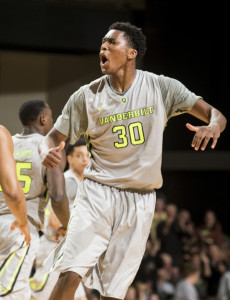
players and coaches explicitly state their goals or simply visualize them internally may vary, but regardless these expectations determine the lens through which the season is viewed by all.
There’s little doubt that this year’s Vandy squad is the most talented since 2012, and the goals and expectations of players and fans alike reflect this reality. Fan and media expectations have steadily ramped up over the last few months (I would argue artificially so, considering there have been no roster changes over the summer) from “top 4 in the league” to “Sweet 16 or bust,” or some similar variant. The truth, however, is that in a sport whose championship format is single elimination, a team’s ability may not be measured accurately through their postseason performance. It all depends on the draw, even for teams as great as what Kentucky had last year. For Vandy, I would urge everyone to dump specific expectations for how far the team advances in the NCAA Tournament. The Dores could have a disappointing regular season and still win multiple tournament games come March, or they could explode en route to a top-4 seed before getting upset early. For this year, this team should be measured by overall regular season performance. Next year is when we can start getting worked up about meeting specific postseason benchmarks. For now, just sit back, relax, and enjoy the ride back to national relevance.
The Team
Vanderbilt’s talent is what will put it in position for success, but it’s the team’s depth and the resulting flexibility that will help lock up a top tier SEC finish. While the team may not have the most well-rounded options at small forward and power forward, positions have become less meaningful in basketball over the last few years. The Dores roll two, three or even four deep at every position, thanks to the solid positional versatility of guys like Jeff Roberson, Matthew Fisher-Davis, and Riley LaChance.
The only true weakness of this team will be its ability to rebound, particularly on defense. This is reflected in the statistics, as the Dores’ weak points last year were turnovers and defensive rebounding. The turnover problems should mostly take care of themselves as Wade Baldwin improves his understanding of how to run the team and as LaChance takes over for turnover machine Shelton Mitchell when Baldwin is off the floor. Coaches and players alike have no reservations about LaChance’s ability to run the point, and if nothing else he should take care of the ball based on the exceptional 13.6% turnover rate he posted as a freshman. Baldwin had issues at times last year running the offense, and had a tendency to put teammates in disadvantageous positions on the court with his passes (see the end of the UGA and UT home games). As the year went on, however, he mostly cut this out of his game. At this point in time, all indications are that Baldwin is far ahead of where he was last year in terms of his understanding of how to play the point guard position and how to run the team. Finding someone who can consistently break the defense down off the dribble may prove to be a challenge for Stallings, but Baldwin, LaChance, and perhaps Nolan Cressler and Joe Toye provide some hope in that department. With the way Vandy wants to play offensively, however, this represents much more of a marginal problem than a fundamental flaw.
When it comes to rebounding, the addition of freshman bruisers D’Jery Baptiste and Samir Sehic should help on the defensive end. The departure of James Siakam, however, means Vandy will be hard pressed to offensive rebound as well as they did last year. Improvements on the defensive boards would go a long way toward helping VU avoid bad losses to bottom tier SEC teams this season, as the worst teams in the league usually still have high level athletes and can therefore thrive on the offensive boards. Whether below average defensive rebounding will really kill the Dores in the long run, however, is up for debate. The chart below suggests that Sweet 16 teams since 2012 (I know I said this shouldn’t be an explicit expectation; I’m simply using this as a way to isolate a measurable and objective grouping of good teams) have done a slightly better job controlling turnovers than limiting opponents’ offensive rebounds. 16 out of the 48 teams studied were below average for all of Division I when it came to defensive rebounding, whereas only eight were below average when it came to turning the ball over. While this hardly represents clear and convincing evidence, the trend is worth noting and does bode well for VU.
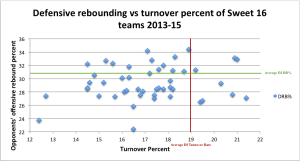
Despite this possible trend, VU will still need some improvement on the defensive boards in order to let their strong first shot defense mean something. Damian Jones would do well to push his decent 16.5% defensive rebounding rate up to 19 or 20, which in raw terms would equate to about 7.5 total rebounds per game compared to the 6.5 he corralled last year. Similarly, it would be a big boost if Sehic and Baptiste could rebound at rates in the high teens as well when they are on the court. Luke Kornet is the number one guy who needs to show improvement in this area, however. Luke’s 12.5% defensive rebound rate last season represents a number that’s roughly average for a small forward, much less a 7’1” big man on a team devoid of defensive rebounding to begin with. Wade Baldwin himself corralled an extra 2% of available defensive boards despite the fact that he gives up about 10 inches to Luke. Kornet has put on a bit of weight in the offseason and looks ready for a good year, but he needs to prove he can rebound at least adequately for his position.
The Four Factors
A big advantage for the Commodores is that the team’s biggest strengths overlap with the most important factors when it comes to determining the outcome of a season or even of any one game. We see this via noted basketball analytics guru Dean Oliver’s Four Factors, which represent the four aspects of basketball that play the biggest role in how effective a team is offensively or defensively. Effective field goal percent is the biggest of the four, followed by rebounding and turnovers in a tie for second with free throw attempt frequency bringing up the rear. Effective field goal percent simply accounts for the fact that shooting 33% from three is just as good as shooting 50% from two, so a team with a high EFG% is very efficient shooting the ball from any distance. All this says that scoring efficiently and preventing the opposition from scoring efficiently are the two most important parts of basketball. Vandy has those bases covered.
Despite VU’s decent, but far from great, defensive efficiency of 100.1 points per 100 possessions last year (114th in DI, adjusted for strength of schedule), the team’s effective field goal percent defense came in at a strong 46.6%, 72nd in the NCAA. The lower overall defensive efficiency was a result of poor defensive rebounding and the lack of turnovers forced, but it’s clear the Dores played good first shot defense a year ago. That’s a great start, and this is an indication that the team’s young guards have a good foundation when it comes to defense.
VU’s offensive efficiency of 113.9 ranked 19th in the NCAA when adjusted for quality of opposition, a number that is truly off the charts for a team that relied on so many freshmen. With versatile scorer Nolan Cressler eligible this year to go along with what is expected to be some significant freshman-to-sophomore improvement, the offense is going to be nasty. Incoming freshman Camron Justice may be one of the most skilled first year players in the SEC with his shooting and ball handling abilities, and he may not even see the court in non-blowouts. All this shooting should open things up even more for Damian Jones, and the loss of Siakam could help even more here, despite the Cameroonian’s sky-high offensive efficiency last year. For as great as Bamba was, he wasn’t a threat on the perimeter and opposing teams didn’t have to respect his jumper. This season, Damian will likely be surrounded by four top-shelf three point shooters at all times, which will make it extremely difficult for opponents to double team him in the post. One of Dame’s major weaknesses is his feel for the game and court vision, so if he can improve both of those and start racking up assists out of double teams early in the year, it’ll make VU’s offense nearly unguardable.
I briefly touched on this earlier, but it bears repeating that the team’s one offensive weakness will probably be the lack of an elite creator off the dribble. Wade Baldwin has proven he can be an effective drive and kick player, but his finishing at the rim leaves a lot to be desired. This weakness resulted in something of a statistical rarity last year, as Baldwin shot a better percent on threes than twos despite the fact that his shot distribution was fairly even between three point shots and shots inside the arc. Wade is more of a smooth and fluid athlete than a truly explosive one, but he’s more than good enough to increase his 42% shooting percentage from inside the arc, and the sophomore has been working against Damian Jones and Luke Kornet in the offseason to improve his ability to finish against elite length. Better ball handling could help his cause, and he’s going to need improvement if he’s to establish himself as a legitimate first round NBA prospect in the long run. This following scatterplot shows Wade’s two point and three point shooting percentages compared to first round point guards from power conferences since 2011, and the Commodore lead guard is fairly isolated compared to most of these other prospects. If Baldwin’s strong outside shooting continues this season, then he provides better range than most teams would require from a point guard prospect. Lumping Wade in with these players sets a high standard, but I think it’s fair to say that first round status is his eventual goal.
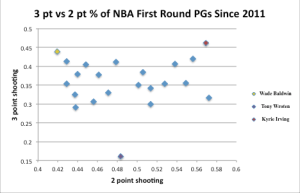
The Rotation
Kevin Stallings is in a position that many coaches across the country envy, as the Dores can go deep into their bench without sacrificing much quality in terms of on-court production. Damian Jones and Wade Baldwin seem good for nearly 35 minutes per game in competitive matchups, but I expect Stallings to manage the pair’s minutes in order to keep both around 30. This should be doable if VU can blow enough opponents out, and for this reason I doubt anyone will play over about 31-32 minutes per game.
Stallings has similarly said he hopes to cut down Riley LaChance’s minutes from 33.3 a year ago, and the excess of talented 2-guards available with the arrival of Cressler and Justice makes this an easy task to accomplish. The logjam on the wing also means that minutes will be scarce for Justice and possibly Joe Toye, as Stallings alluded to this month in noting, “we’ve got some guys who aren’t going to play.” By all accounts, Justice and Toye are talented players, but they have to beat out similarly talented guys who have a one year head start over them. As such, I expect Justice to be largely out of the rotation, along with either Toye or Samir Sehic. Sehic’s rebounding could keep him on the floor, but his high school shooting numbers leave a lot to be desired and concern me for someone who’s described as an inside-out big man who compares himself to Kevin Love. 34% three point shooting to go along with 58% free throw shooting senior year isn’t particularly good, and I doubt Sehic will immediately step on the court and provide efficient floor spacing. If Sehic does shoot the ball well, he’ll probably be in the rotation as Luke’s backup. If not, then expect to see Toye play more while Roberson plays significant minutes at the 4 (which will probably happen anyway). Big D’jery should find his way onto the court no matter what, as any experience he gains now represents an investment in the Commodores’ future frontcourt. Baptiste isn’t going to provide much on offense, but he brings a level of physicality and athleticism that Josh Henderson doesn’t. I would be disappointed if he rides the pine for much of the year, as I think Baptiste’s supposed lack of offensive ability has been way overblown; VU has so many scoring guards that no backup center should be getting a significant amount of post touches regardless.
My current expectation is that the rotation will consist of Baldwin, LaChance, Fisher-Davis, Kornet, Jones, Cressler, Roberson, Baptiste, and Toye for much of the year, with Cressler eventually moving into the starting lineup for Fisher-Davis if the Cornell transfer is as good as advertised. I’m all-in on the three-guard lineup, for the simple reason that it gives VU the ability to put its best five players on the floor at any given time.
The Schedule
If you want to see what a tough nonconference schedule looks like, go ahead and log on to vucommodores.com and take a look. Combine this gauntlet with a typically strong SEC slate and Vandy may end up with one of the top five schedules in all of college basketball by the time the NCAA selection committee heads back to their secluded Indianapolis conference room. Teams with a tough nonconference schedule consistently get the benefit of the doubt with respect to seeding, and we saw this once again last year as Xavier (21-13) and Georgetown (21-10) ended up with 6 and 4 seeds respectively due largely to the quality of competition both played over the course of the entire year, not just during Big East play. Vanderbilt simply isn’t going to rack up 26 or 27 wins with the schedule they have. Personally, I’d be surprised if they even get to 24 in the regular season. The Dores will surely take their fair share of losses this season, but it doesn’t matter. Even a 9-4 record against that monster of a nonconference schedule would keep them in very comfortable position, especially since most people who follow the program expect the team to peak later in the year.
The only worrisome aspect of the schedule is the fact that the Commodores put together a dismal 2-6 record against NCAA Tournament at-large teams a year ago. The good news is that all of those losses were competitive, and some amount of luck was involved in how those results were distributed. The reality, however, is that not all points are created equal; it’s much harder to score against an NCAA Tournament team in the last minute of a one-possession game than against Western Carolina in a blowout. VU showed some resolve on the road with wins against Tennessee, Alabama, and Ole Miss, which is significant considering all but one of the Dores’ most challenging nonconference games are away from Memorial Gym. We’ve seen that VU can compete with high quality teams, but there isn’t any evidence that they can beat them on a consistent basis. All the Dores have proved so far is that they are good for a .500 or better record in conference. Clearly this isn’t the deciding factor in how I see the 2015-16 season panning out, and I do expect this trend to reverse itself to some degree. It is, however, an aspect of the team’s play last season that’s worth mentioning, and few are taking it into account. It’s difficult to all of a sudden jump from a 19-13 regular season team against a middling schedule to a top 15 team in the entire country. Based on this concept of mine, I’m somewhat “low” on the Commodores compared to most fans and media, but I’d be shocked if this team isn’t dancing away come March. Whether they can do more remains to be seen, and won’t be clear until the bracket itself is out. All this sounds pessimistic, but this will be a fun team even if they take some losses early on. No matter the team’s eventual seeding, I’m more than confident enough to say that Memorial Magic is back.
PREDICTION: 21-10 (12-6 SEC) regular season, 5 seed in NCAA Tournament
Check out VandyRadio’s comprehensive Vanderbilt sports blog series. Building the Masonic Tradition covers Commodore football, The Black & Gold Standard covers VU hoops, and Eyes of the Hawk covers Vandy baseball. VandyRadio.com is your home for year-round coverage of your favorite Vanderbilt teams.


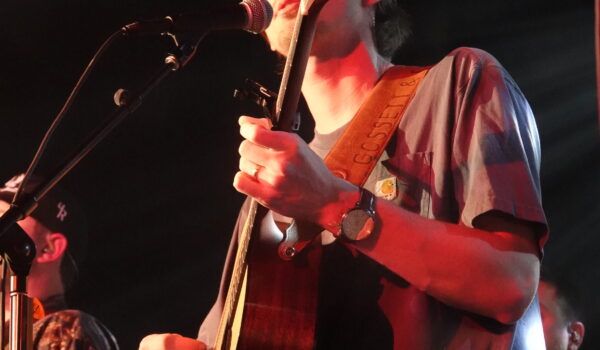



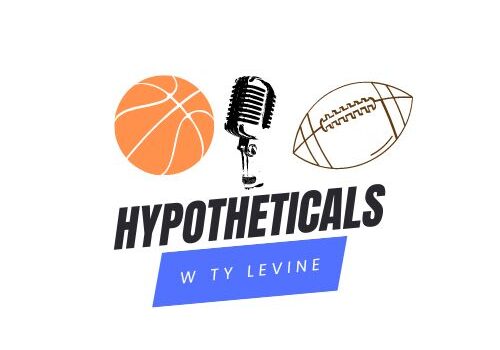

Comments